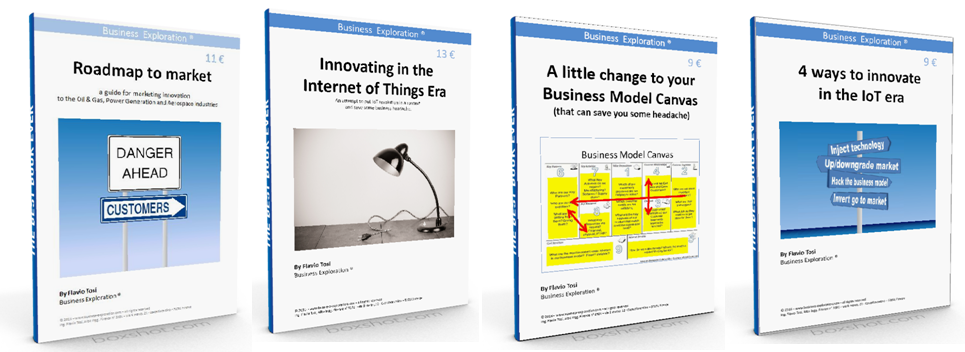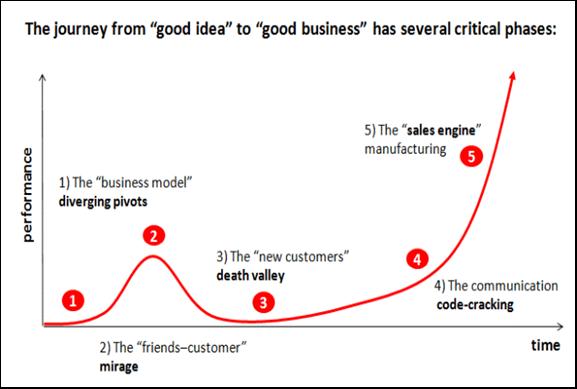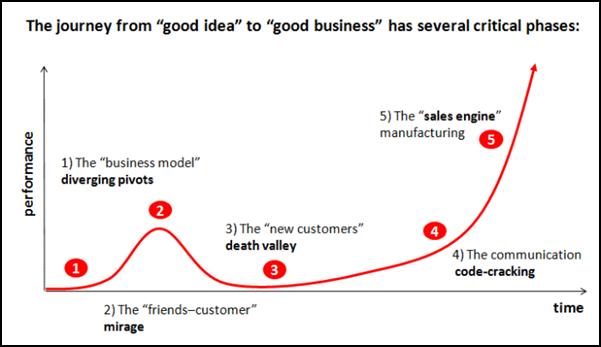

|
Avoid these critical cross points in launching a business… |
|
Avoid these critical cross points in launching a business… |
Dear Fellow Innovator,In my more than a decade long journey supporting entrepreneurs and innovators go-to-market efforts, I have repeatedly encountered some critical cross points, where businesses struggle to move forward. This is a list of the most common. If you know them, you skip them.
1) The business model’s “diverging pivots” This cross point it’s where initial ideas fail to converge to a good enough business model. Most of the times the team tries to handle an overreaching complexity, having on one hand a deep understanding of field domain know-how, and in the other a just approximate experience in general management and market scenarios development. The result is the inability to find a backbone organization model to support consistent growth, and, ultimately, they end up running out of cash. 2) The “friends-customers” mirage If the idea finds easily appreciation among the proximity network made of friends, acquaintance and personal estimators, the team can reach a momentous omnipotence feeling, with the risk of forgetting to take advantage of the lucky moment, to build a proper sales model. It’s the risk of misinterpreting personal branding with “exceptionally good ideas that self-promote” i.e. are viral or embeds elements of viral marketing. 3) The “new customers” death valley As a direct consequence of point number 2, failing to build a repeatable sales process, will appear once the “friend-customers” honeymoon will deplete all personal branding business opportunities. The “cash-strapped” wolf will soon accompany the team’s crossing of the “new customers” death valley. No Customers will appear on the horizon, until the full run-out of resources or the arrival on a promise land. I.e. reaching a point where (admittedly: by luck and trial & error) the communication code to intercept customer’s attention is found. 4) The communication “code cracking” The promise land is almost always made of two ingredients: 1) a generous customer 2) a very good argument. 5) The “sales engine” manufacturing The teams that starved through all the 4 previous phases, but succeeded in cracking the code, have finally the chance to rethink their go to market. The business idea is there, the team is there, the operational processes are there, even the communication is in its embryonic form, but it’s there. Now it’s the turn of making repeatable sales really r-e-p-e-a-t-i-b-l-e. Here much of the complexity of the original solution has gone, so the level 1 of Sales engine process is almost always at reach. Building a commercial network and beating the bush is something that makes orders fly. But what a fatigue! Each of these phases confront with some specific problem as: · assess the business model · land initial orders · prove go to market plans · accelerate business growth · overcome the price objection · develop customers communities · exploit service and aftermarket potential Almost always these problems are cascade generated by a trial and error approach, instead by a good planning of experiments. ( yes, experiment and trial are not the same thing…) The entrepreneur tries to take care of the critical joint between the technology side and the market side of their business model, adding a layer of “go to market” complexity to the already complex layer of “technology development”. And if the second is often a sound domain of knowledge, the first, is more than often a “debut” without parashute. Joining a business community, a lab, an incubator, could be a first step to learn from the ones that -avoided the mistake- before you. Cordialmente Flavio The best way to reward this post is with your “like”
versione italiana I Pensierini Notturni Caro Collega Innovatore, Nel nostro viaggio, ormai più che decennale, a supporto degli sforzi commerciali di imprenditori e innovatori abbiamo più volte incontrato alcuni momenti critici ricorrenti, in cui le aziende lottano per riuscire a superarli. Se li conosci, li eviti.
1) “Iterazioni divergenti” del modello di business È la fase nella quale le idee iniziali non riescono a convergere ad un modello di business abbastanza buono. La maggior parte delle volte la squadra cerca di gestire una complessità sovverchiante, avendo da un lato una profonda conoscenza di dominio tecnologico, e dall’altro una esperienza appena approssimativo della gestione di uno sviluppo di business all’interno di molteplici scenari di mercato. Il risultato è l’incapacità di trovare un modello di organizzazione che sia spina dorsale per sostenere una crescita costante, e, in ultima analisi, la rottura di cassa. 2) Il miraggio degli “amici-clienti” Se l’idea trova facilmente apprezzamento tra la rete di prossimità fatta di amici, conoscenti ed estimatori personali, il team può raggiungere una sensazione momentanea di onnipotenza . Con il rischio di dimenticare di approfittare del momento fortunato, per costruire un modello di vendita adeguato. E’ il rischio di mal interpretare il “personal branding” per “idee eccezionalmente buone idee che si vendono da sole”; che cioè sono virali o incorporano elementi di marketing virale. 3) La valle della morte dei “Nuovi Clienti” Come diretta conseguenza del punto numero 2, il non riuscire a costruire un processo di vendita ripetibile, diverrà manifesto una volta che la luna di miele degli “amici-clienti” porterà all’ esaurimento di tutte le opportunità di business date dal branding personale. Lo spettro della fame accompagnerà presto il team nel suo attraversamento della valle della morte “dei nuovi Clienti”. Qui, nessun cliente appare all’orizzonte, fino al totale esaurimento delle risorse o l’arrivo in una terra promessa. Che accadrà solo raggiungendo il punto in cui (ammettiamolo: per fortuna e a furia di provarci) il codice di comunicazione per intercettare l’attenzione del cliente verrà trovato. 4) La soluzione del “rompicapo di comunicazione” La terra promessa è quasi sempre fatta da due ingredienti: 1) un cliente generoso 2) un buon argomento. Il primo è necessario per ricevere risorse sufficienti per uscire dalla pista nella valle della morte. Il secondo è quel momento magico in cui la squadra ottiene quell’ imprevedibile momento della verità in cui (ta-dah!) le parole chiave per attirare l’attenzione del cliente vengono identificate. Se non fosse stato per l’imprevedibilità quasi totale della metodologia utilizzata per ottenere quella parola chiave, si dovrebbe consentire al team di festeggiare … 5) La creazione del “motore di vendita” La squadra che attraversa affamata tutte le 4 fasi precedenti, ma è riuscita a violare il codice, ha finalmente la possibilità di ripensare come andare sul mercato. L’idea imprenditoriale è lì, la squadra è lì, i processi operativi sono lì, anche la comunicazione è nella sua forma embrionale, ma è lì. Ora è la volta di effettuare vendite ripetibili davvero r-i-p-e-t-i-b-i-l-i. Qui gran parte della complessità della soluzione originale è andata, quindi il livello 1 di un processo di vendita è quasi sempre a portata di mano. Costruire una rete commerciale e battere il mercato è una cosa che fa volare qualche ordine. Ma che fatica! Ciascuna di queste fasi si confronta con qualche problema specifico: · valutare il modello di business · ottenere I primi ordini · dimostrare la bontà del piano commerciale · accelerare la crescita del business · superare l’obiezione sul prezzo · sviluppare una comunità dei clienti · sfruttare il potenziale del post-vendita Quasi sempre questi problemi sono generati in cascata a casusa di un approccio per tentativi, invece che di una buona pianificazione di esperimenti. (Sì, esperimento e tentativo non sono la stessa cosa …)
Per parlare di questo, cordialmente, Copyright © 2016 Business Exploration ®, All rights reserved. Se ti è piaciuto questo post, e vuoi riceverli tutti. The best way to reward this post is with your “like” |
|
Little nightly thoughts by Business Exploration® |
|
Read more about marketing innovation, ask our free booklets: here |

|
Puzzled by your Marketing Plan? |

|
Get our free booklet: Roadmap to Market
And discover our methodology
Satisfied or Reimbursed |
|
Our Newsletter reaches 2200 professionals in 47 nations, with the ambition to offer alternative points of view and a relax break to our readers. |




